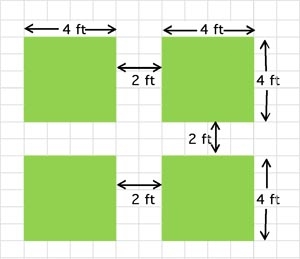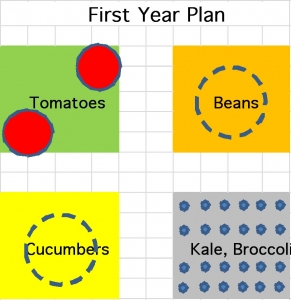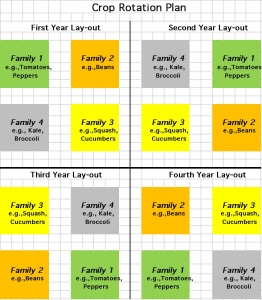Beginners’ Guide: Planning A Vegetable Garden
The Easy Way
By Gil Medeiros, former Fairfax Master Gardener
If you are new to vegetable gardening, winter is the perfect time to think about what shape your backyard produce patch will take in the year ahead. As one option, here is a simple plan to create a 100-square-foot plot. It is a great starter size — large enough to yield a reasonable harvest, yet small enough to make maintenance manageable.
 Hopefully, you already have a spot in mind with the right sun requirement (at least six hours of direct sunlight during the growing season); and hopefully, you have already begun to prepare the soil. (See Create A Vegetable Garden The Easy Way). If so, you are ready to take the next steps in making that vegetable garden a reality.
Hopefully, you already have a spot in mind with the right sun requirement (at least six hours of direct sunlight during the growing season); and hopefully, you have already begun to prepare the soil. (See Create A Vegetable Garden The Easy Way). If so, you are ready to take the next steps in making that vegetable garden a reality.
Laying out the garden
To begin, divide 100 square feet of garden space into four beds that are 4 feet by 4 feet, separating these beds with 2-foot-wide walkways. The bed dimensions make it easy to construct planting boxes. Doing so with no waste requires two 8-foot-long, 2-inch-by 8-inch boards, a convenient size to transport without renting a truck. When filling boxes, follow the directions given in our vegetable garden article (link is in the paragraph above). Of course, planting boxes are optional; you can also simply mound soil in the 4-by-4 squares.
Squares of this size will allow access to plants from all sides without having to step in a bed. If children are going to help tend this garden, though, consider reducing the bed width to 3 feet. The paths are wide enough to accommodate a wheelbarrow and can be “paved” with shredded leaves, wood chips, bark mulch or straw to control weeds.
Now comes the fun part—thinking about what to plant and where to plant it. In making those decisions, though, you first need to consider the importance of rotating crops.
Crop rotation
You should not plant crops in the same family in the same place two years in a row; better yet, avoid repeating locations for three or four consecutive years. Why? Plants in the same family often fall victim to the same insects and diseases. By rotating crops, you prevent a build-up of harmful insects or pathogens in one area.
Since this simple layout has four garden beds, choose four plant families and rotate them among the beds. Remember to group plants of the same family in the same bed. The four-year rotation plan I will describe incorporates crops in families 1 through 4, listed below. You can, of course, substitute one of them for the fifth family.
Common garden vegetable families
More than 90 percent of American backyard gardeners grow tomatoes; other home-garden favorites include peppers, beans, cucumbers, and squash. When planning your vegetable garden, it is important to recognize which family your favorites belong to, so you can group and rotate families together.
- Nightshade: tomatoes, peppers, eggplants, potatoes
- Cucurbit: zucchini squash, crookneck squash, winter squash, cucumbers, pumpkins
- Legume: beans, peas
- Brassica: Broccoli, cauliflower, kale, cabbage, Brussels sprouts,/li<
- Allium: Onions, garlic, leeks, chives
Nightshade family
I recommend that beginning gardeners use hybrid tomatoes instead of “heirloom” varieties. While the heirlooms produce great, flavorful tomatoes, they are more prone to disease and more difficult to grow. Hybrids, however, are bred for disease resistance and other attributes. You can easily identify hybrid tomatoes at the garden center. Check their stickers for letters such as V, F, T, and N; these represent diseases or pests to which the plant is resistant.
You must also distinguish between tomatoes with indeterminate vines, which are long, and determinate vines, which are relatively short. You can fit more plants with determinate vines into a small space. The indeterminate vines grow throughout the season, often producing larger yields. The plant’s sticker or the seed-packet description will tell you whether the plant is determinate or indeterminate. In a 16-square-foot bed, you can plant four determinate tomato plants but only two indeterminate plants. Indeterminate vines require staking, while determinate vines prefer tomato cages. Vine length does not correlate with tomato size. Cherry tomatoes often grow on indeterminate vines. Read the plant sticker or seed label carefully to know what you are getting.
Peppers come in many shapes, flavors, colors and sizes. In Northern Virginia, peppers start slowly in spring but are often productive until first frost. (As I write this in mid-November in Falls Church, my peppers are still producing very well.) Bell, banana and chile peppers all perform well here. Garden centers carry varieties to suit every taste.
Nightshade family members are best planted as small plants started indoors in late winter or early spring. Don’t be in a hurry to plant them in early May unless the weather is warm. One planting option for the Nightshade group is two determinate tomato plants and two pepper plants in the same bed.
Cucurbit family
The varieties that grow as vines (cucumbers, winter squash and pumpkins) can cover a lot of ground. Unless you have adjacent overflow space where vines can spread, avoid planting winter squash and pumpkins. Grow cucumbers on a temporary trellis structure to save space and keep the cucumbers off the ground.
Zucchini and summer squash plants grow in bush form, but the plants can grow quite large. One or two plants can cover an entire 4-by-4 bed and provide enough squash to satisfy most families. Many garden centers sell cucumber and squash seedlings, but I recommend that you leave them at the store and plant cucurbits as seeds sown directly in the garden. A 30-seed packet should be sufficient for the garden outlined.
Peas are great in the backyard garden, but peas are a cool-weather crop that must be planted in early spring; they will be finished by summer. If you cannot get outside to work the soil early, plant beans instead of peas. Beans can be grown as vines on a moveable trellis or as low bushy plants. I have grown both; I prefer the vine varieties, known as pole beans, because they are easier to harvest. Plant these as seeds sown directly in the garden. One seed packet of 30 seeds should suffice. Plant half the seeds in early May and the rest three weeks later to extend the harvest.
Brassica family
Kale, popular for its nutrition value, is easy to grow. Unless you plan to consume a lot of kale, plant another brassica member, such as broccoli, in the same bed. Brassicas are best planted in April, as seeds sown directly in the garden.
Allium family
Onions and garlic are usually planted in fall as bulbs or seeds. (See garlic.) You sow onion plants, however, in early spring for a summer harvest. Look for these online or in seed catalogs, sold in 50-to-60 plant bundles. You will see three types: long-day for northern latitudes, short-day for southern latitudes, and day-neutral for mid-latitudes. You want day-neutral in Virginia. Plant them in late March or early April. Two 50-plant bunches will fill one of your beds.
How to rotate
 Keep it simple. From year to year, move the plant families clockwise around the garden, as illustrated here. In the fifth year, use the layout for year one.
Keep it simple. From year to year, move the plant families clockwise around the garden, as illustrated here. In the fifth year, use the layout for year one.
The first year
To start your garden, choose plant varieties that are easy to grow and find. As you gain experience, try some different varieties. Gardening is about experimentation. My suggestions for the first year are shown below. You can find them at local garden centers as plants or seeds.
| Species | Variety does well here | How much? | Other requirements |
| Tomato | Better Boy VFN* | Two plants to be transplanted | Support each plant with a stake that is at least 5 feet high |
| Bean | Kentucky Wonder pole beans* | One seed packet | Erect a “teepee” or other temporary trellis to support the vines |
| Pepper | California Wonder bell pepper | Four plants to be transplanted | Support with small tomato cages |
| Cucumber | Marketmore | One seed packet | Erect a “teepee” or other temporary trellis to support the vines |
| Kale | Dwarf Blue Curled Vates* | One seed packet | |
| Broccoli | Packman hybrid* | One seed packet | |
| Onion (day-neutral) | Ailsa Craig Exhibition yellow onions, Sierra Blanca white onions, Candy yellow onions | Pick one or two varieties. Plant two bunches of 50 plants each | Not likely sold at local garden centers. Order online. |
| *Recommended by Virginia Cooperative Extension | |||
References
Raised Garden Bed Dimensions, (C1027-4), UGA Extension
Vegetables Recommended for Virginia, VCE Publication 426-480
